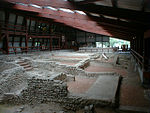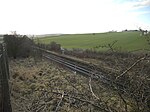Eynsford railway station
1862 establishments in EnglandBuildings and structures in Sevenoaks DistrictFormer London, Chatham and Dover Railway stationsPages with no open date in Infobox stationRailway stations in Great Britain opened in 1862 ... and 4 more
Railway stations in KentRailway stations served by Govia Thameslink RailwayRailway stations served by SoutheasternUse British English from August 2015

Eynsford railway station serves Eynsford in Kent, England. It is 20 miles 32 chains (32.8 km) down the line from London Victoria and is situated between Swanley and Shoreham. Train services are provided by Thameslink.
Excerpt from the Wikipedia article Eynsford railway station (License: CC BY-SA 3.0, Authors, Images).Eynsford railway station
Shoreham Road,
Geographical coordinates (GPS) Address Nearby Places Show on map
Geographical coordinates (GPS)
| Latitude | Longitude |
|---|---|
| N 51.363 ° | E 0.204 ° |
Address
Eynsford
Shoreham Road
DA4 0HP , Eynsford
England, United Kingdom
Open on Google Maps










